Its time for another newsletter - and the reflection that there is but one before Christmas, and then one more before another year, the time when we plan to change of many things and seldom do. The problem is the many things; for one would not only be easier to change, but would take less time if all your energy was focused only towards that.
This week I have found all the small things that go towards the building of this newsletter to be a very good distraction from what I was trying not to think about. And it came together quite easily. All of the diary dates I wrote down first turned out to be on the right day, which is not always the case, and only one subject had to be changed as it was too obscure to have appeared on a card. I kind of knew that when I wrote it down, but hunted for way too long, just on the off chance. As for my first choice for the 15th, well I decided to leave that in the box, though I do have several cards, and all of them are quite amazing! Maybe next year though.....
So settle down, and allow the stories of this week`s final selection to be told.....
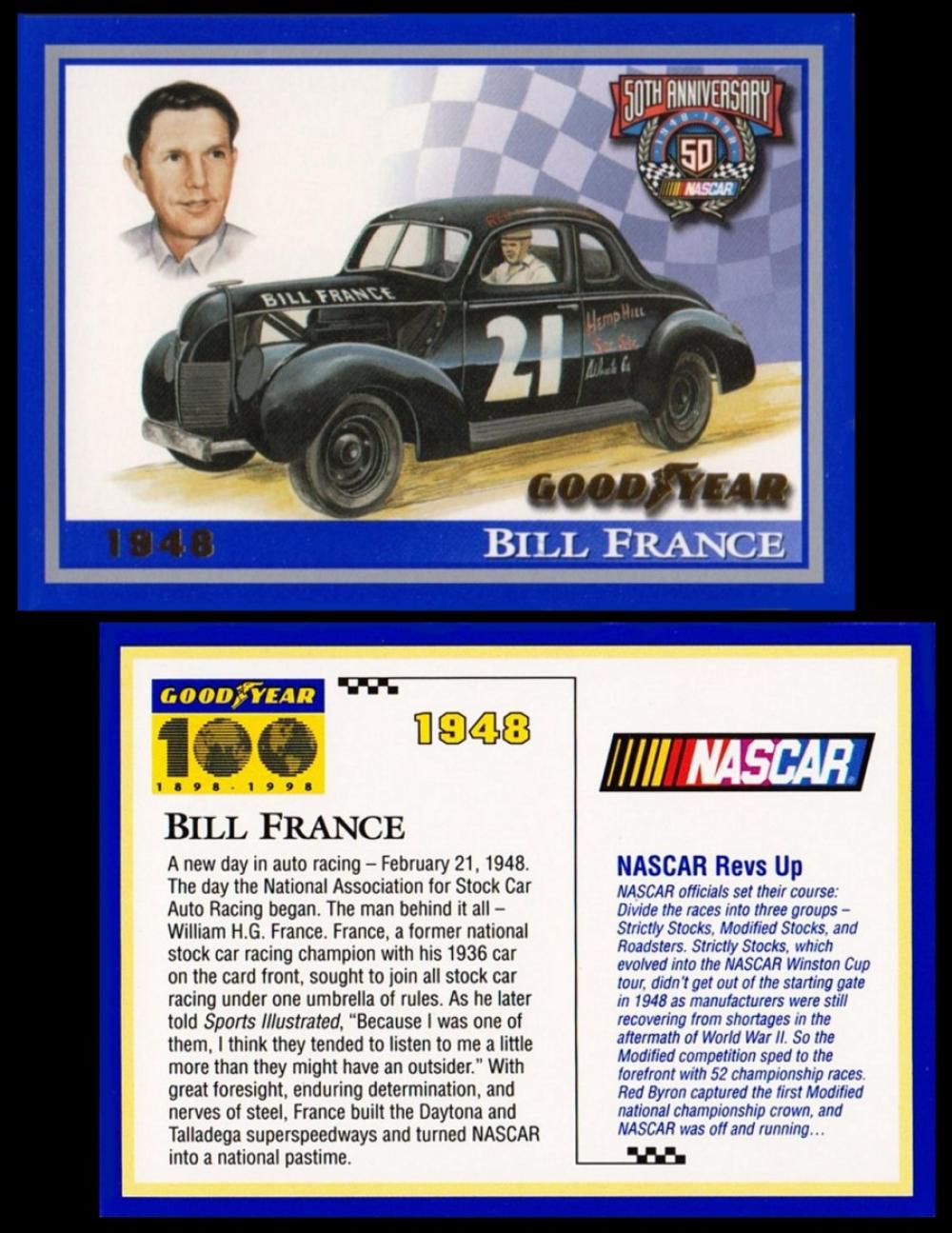
Goodyear Tire & Rubber Co. [trade : car parts : O/S - USA] "NASCAR 59th Anniversary Collection" (1998) Un/51
We start with a birth, but not of this man, William Henry Getty France, that was in September 1909. The birth we celebrate is that of NASCAR, or the National Association for Stock Car Auto Racing, which happened today, in 1947.
Bill France was a keen racer, and would take the family`s Model T Ford down to his local racetrack whenever he had the chance, starting whilst he was still supposed to be in school. He held several small jobs, from which the money was saved until he could buy a gas and service station. He enjoyed working there, but then the family had to move, and fortuitously they ended up at Daytona in Florida, which was the test bed for several land speed record attempts and successes. However, and not long after, these relocated out to the salt beds in Utah.
In an attempt to keep Daytona a motor racing town, plans were laid for a race, and the course was hurriedly built, using several of the roads in the area, hence it became known as the Daytona Beach Road Course. That first race was in March 1936, and it ran over seventy-eight laps of the track. It was called a Stock Car Race, but unlike what that term means in England, an American Stock Car is a car without modification, and totally legal to drive on the road to and from the event. In addition the cars taking part had to be built within the last year The prize was the quite astounding five thousand dollars, almost half of which was to go to the winning driver. However, despite its popularity, the event lost much money, four times as much as the promised purse, and suffered many complaints from drivers, especially those whose road cars were unable to gain traction on the beach part of the course. Worst of all, most of the spectators tickets were unsold because people realised that they could stand on the beach and watch the action for free. There was something very notable about the event though, and that was that Bill France took part, coming home in fifth place.
As much as he had enjoyed the race, he knew that the organisation was poor; he found a fellow racer and they proposed to run another event the next year. This still lost money, but nowhere near as much. That kind of put the dampers on it for his friend, but Bill France had the bug and he took over as the sole operator, with the proviso that he could also race.
The races kept going until 1941, then America entered the Second World War. There was no racing until after the war, but then Bill France was off on the road again, competing in as many events as he could, and also promoting events. He also built a track, in North Carolina, in 1947. Then, at the end of that year, he called everyone he knew from the motor racing world and brought them down to Daytona. The first meeting took place today, December 14th, and the idea was to share their feelings, what worked, and what did not, and how money could be made and lost, and at the end of those talks Bill France formed NASCAR.
Now it seems to have got off to a slow start, but in at the start of the 1950s tourism was taking off in Florida, and Bill France somehow got Daytona to agree to the building of a permanent race car track, which would contain three permutations of track so that several sorts of events could take place. The building of this started in 1956 and took three years, and in 1959 the first ever Daytona 500 race took place. The winner of that was Lee Arnold Petty, father of Richard Petty, one of the most successful drivers of all time.
Bill France handed over the reins to his son, William Clifton France, known, always, as Bill France Junior, in 1972, but lived for another twenty years, long enough to see himself immortalised in several motorsports Halls of Fame. According to the Trading Card Database/BFS he also might have seen himself on two cards.
Our card was issued after his death, and it marks the fiftieth anniversary of the founding of NASCAR. Though it is not numbered, our card carries the earliest date so is regarded as card number one. Whilst the fifty-first card is the checklist. Several of the most successful drivers also appear more than once, but Bill France Senior appears only at the start, as befitting the founding father. By the way, Bill France Junior also appears in the Trading Card Database/BFJ
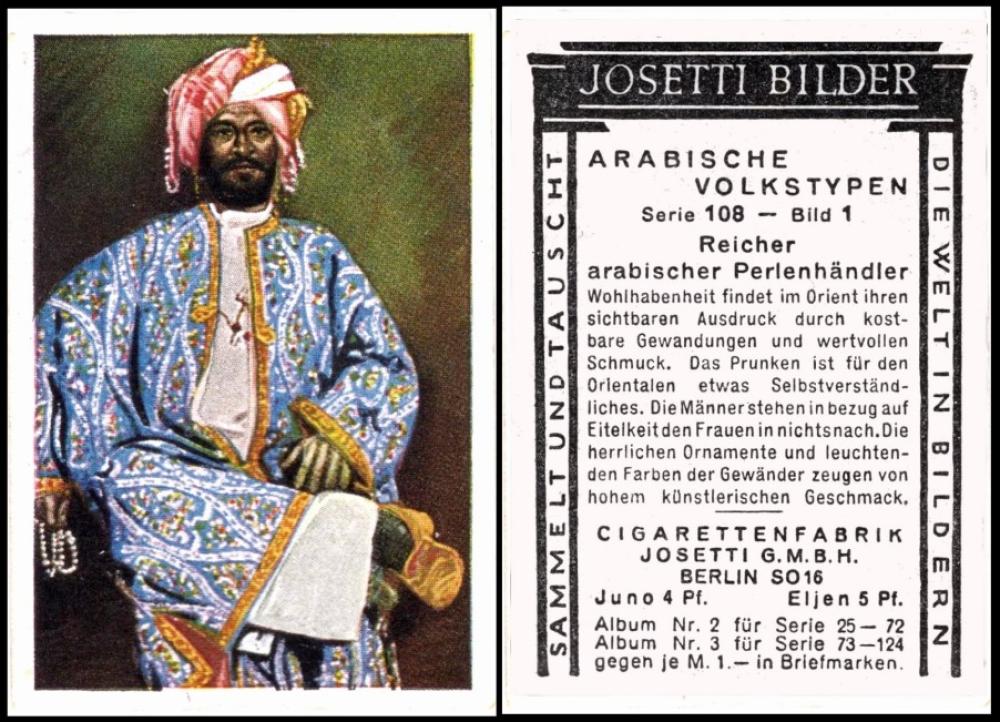
Cigarettenfabrik Josetti G.m.b.H. [tobacco : O/S : Germany – Berlin] “Die Welt in Bildern” Serie 108, `Arabische Volkstypen` (1928) Bild.1 – J915.900.3 : J34-8.3 : X24-8.F
Now today is Wear Your Pearls Day, and so we must, if only because they tarnish and dull if they do not come in contact with the oils in human skin every now and then.
Pearls are a natural substance but start out as a simple piece of grit or dirt, which squeezes inside an oyster and is metamorphosed, over many years, into a pearl. They are not always circular, though, and also not always white, but the traditional string of pearls seems to be white and circular, and this is the form shown on our card, clutched beseechingly in the vendor`s hand.
Now I did not realise when I saw these pearls that Asia was once a huge source of pearls, and that the pearl beds which are sited in the Persian gulf are not only the oldest, being known in Roman times, but also the most reliable at getting a pearl out of almost every oyster. The fame and fortune waned down the centuries, but the second peak, after the Roman frenzies, was in the late 1800s to about 1910. In the 1920s, a way was found to make cultured pearls, and more cheaply, so the Arabian pearls lost their lustre. Then, perhaps, because of this, new industries, including drilling for oil, tore up the pearl beds forever.
As far as cartophilic references you will often find pearls round the neck of an actress or beauty, but there are some other cards that show them. John Player issued a set about astronomy in 1916 and called it "Those Pearls of Heaven - and you can find the squad of the Pearl Assurance Football Club as part of "Photocards F", issued by Ardath in 1936. But for those who prefer pretty ladies, may we suggest that you look for cards of Pearl White, the daring young girl of many silent movies, or even for "Princess Pearl", who was the wife of bandleader Harry Roy but also the daughter of Charles Vyner Brooke, the White Rajah of Sarawak (she appears on card 24/50 of Mitchell`s "A Gallery of 1935")
This card is one of several subsets inside "Die Welt in Bilder", which are all described on the home page for that set, namely the Card of the Day for February the 2nd, 2022
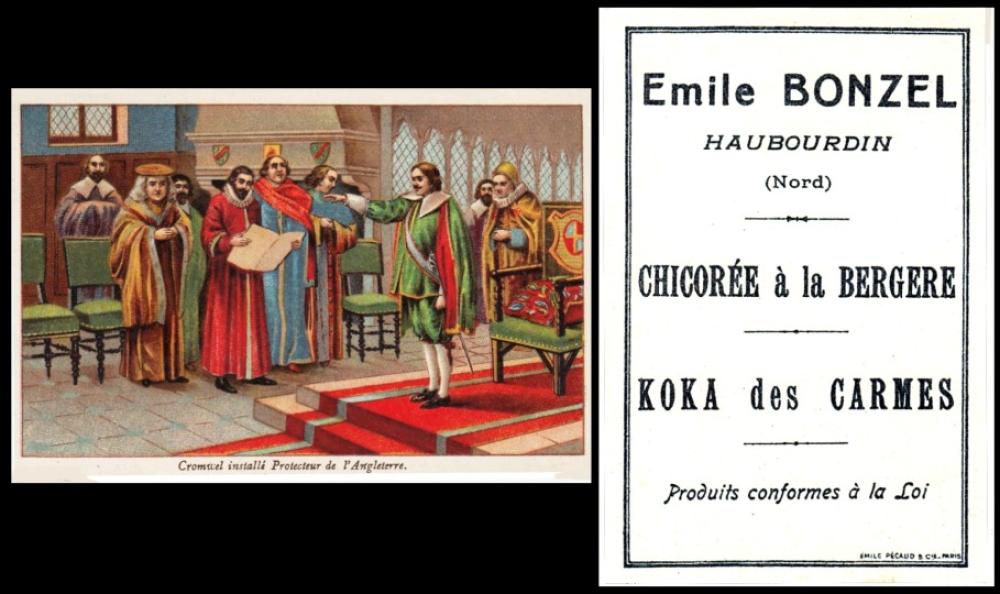
Emile BONZEL [trade : chicory coffee : O/S - France]
Today in 1653 saw Oliver Cromwell become the first Lord Protector of England, as named in the constitution, which he, himself, wrote. This curious job combined being the head of state with the ability of overturning any decision made by Parliament - and it also allowed him to dissolve that Parliament, at any time after the minimum time frame stated in the constitution had passed.
Now there are few cards of his, shall we say, coronation, but this one, a French card, does seem to show that event, though, unfortunately, it calls him "Cromwel" rather than Cromwell. It does seem a very lavish occasion on this card, more fitting the crowning of a King, something you would have thought he would have been opposed to. However, now I have researched this, it does seem to have had much in common with a coronation - and though the first ceremony took place in Westminster Hall on December the 16th, 1653, a second one, which re-installed him in the same post, on June the 26th, 1657, was held in Westminster Abbey.
As far as Emile Bonzel, all we know is that his coffee, made of chicory, was on show at the Paris exposition of 1900 in Paris. Unless there is a researcher of his cards out there who can share more?
This card seems to be hard to research too. I am certain that it is part of a set, but Cromwell seems not to have any connection with France. If anyone knows, do please tell us.
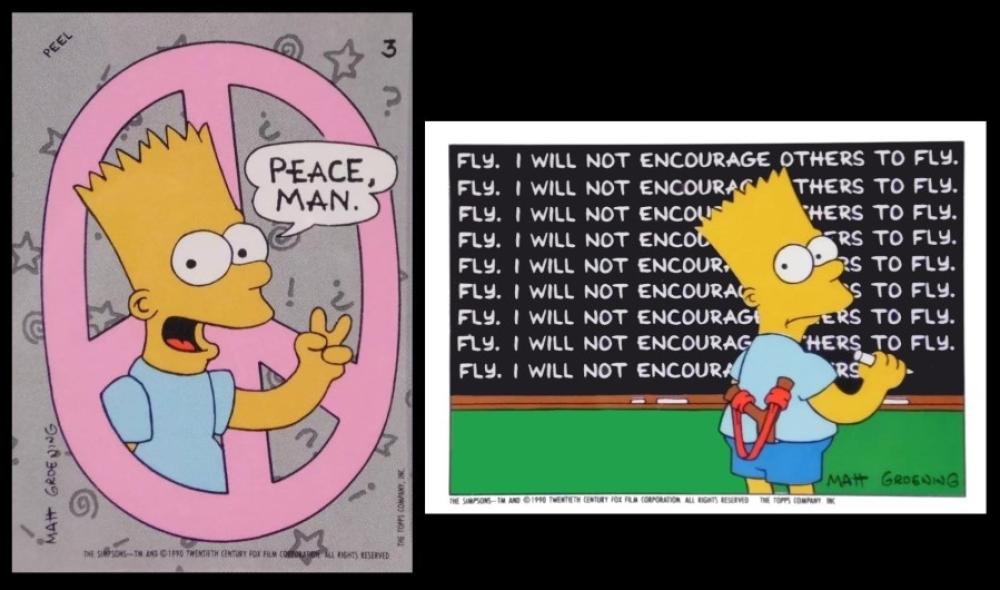
Topps [trade/commercial : cards and stickers : O/S - USA] "The Simpsons" stickers (1990) 3/22
Today in 1989, at least in America, saw the first episode of The Simpsons as a stand alone show, though they had been featured on the Tracey Ullman Show for two years. This episode was entitled "Simpsons Roasting on an Open Fire", and it was actually not the first episode which had been planned, for that had been delayed, due to what are called animation issues, but seem more likely to be difficulties in adapting the art to the screen.
In this episode the son, Bartholomew Jojo Simpson, usually known as Bart, gets a tattoo, and his mum, Marge, has to spend the money she has saved for Christmas on its removal. Unfortunately his dad, Homer, does not get a Christmas bonus at his works and so he is forced to take a seasonal job as a Father Christmas in a local shopping mall.
The Simpsons were anarchic, but human, and the country took to them. The shows were like a pantomime, multi layered, so that adults and children could watch together and get something completely different out of them.
Their appearance on cards came pretty quickly, and the first set was issued by Topps in 1990, this had eighty-eight cards and twenty-two stickers. The front of all the cards show an image inside a television set border, but different backs, whilst the front of the stickers, showing here, showcase the characters on a grey background, and though they all seem to have the same reverse (Bart by a blackboard, writing detention lines), look closely and you will find that each text he writes is different. This is a running gag in the show, and there are lists of what he writes each time if you feel like some amusement - by far the most comprehensive of which is in The Simpsons Archive.
Now the same set of cards was issued in the United Kingdom in 1990, but there do not seem to have been any stickers with it. And the cards are also subtly different, for the American version has quotation marks in the front speech bubble, whilst the British one only has the words. This seems a very time consuming job for no point, but it is the way it is.
There is another odd fact, for these cards were also issued in New Zealand in 1991 by Regina - and they have stickers. However they also used the British artwork without the quotation marks in the speech bubble.
The next manufacturer to produce Simpsons cards was SkyBox, an American manufacturer based in North Carolina. There were only forty cards in the base set, but many subsets, including a set of tattoos which Bart would have well approved of. They also produced a series two, in 1994, again with a short base set of just forty cards, but lots of subsets and some collectors are firm that the "skycaps", which are pretty much pogs by another name, were also a subset, even being issued the same year. Frito-Lay chips also issued circular Simpsons memorabilia, calling them Magic Motion Tazos, in 1996, but there is little chance of confusion because the Frito-Lay ones are tilt and move style.
Now in 1995, (season 6, episode 16), there was a famous episode where the Simpsons went to Australia, called "Bart vs. Australia". This seems to led directly to a set by Tempo of Australia, which was issued in 1996 and was called "The Simpsons Down Under", again this has subsets, but the base set is of a hundred cards.
In the year 2000, two rival sets were issued, one by Artbox, called "Film Cardz", which also had stickers, and spawned a second set "Film Cardz II" in 2003 - and by Inkworks, who advertised their set as "Tenth Anniversary Cards", and quickly followed it up in 2001 with another set called "Simpsons Mania". This is a bit confusing, because Panini also have a set called "Simpsons Mania", issued in 2002 - that link being to a newsletter, so you will need to scroll down to Friday, 24th January 2025. As to why two sets should be called "Simpson Mania", well, there is good reason, because in the year 2000 the Simpsons went on tour all round the world in a stage show, which even came to Britain, and that tour was called The Simpsons Mania Tour.
Lastly, but not leastly, let us chat about another set of Topps cards, issued in 2002, the most amazing fact about these being that they were true trade cards, issued with bubble gum in each pack. The set was of fifty cards, plus foil stickers, and some collectors even count the wrappers off the piece of bubble gum, which was the way that Topps got around the fact that by this time you could no longer issue cards and food together for fear of tainting and choking.
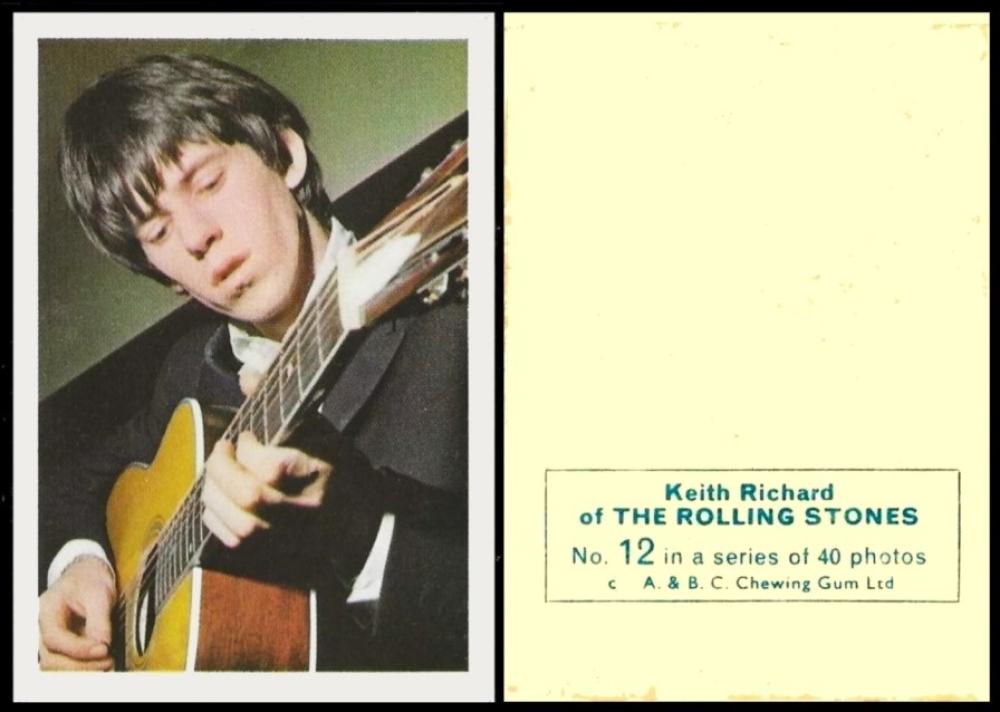
A. & B.C. Chewing Gum Ltd [trade : gum : UK] "The Rolling Stones" (1965) 12/40 -
Today we celebrate the birthday of Keith Richards, shown here - but sadly without his final "S".
He was born on the 18th of December, 1943, in Dartford, Kent, and he joined The Rolling Stones after leaving school. He had actually been at primary school with Mick Jagger, and their meeting again was the stuff of dreams, for Keith Richards was at a train station when he saw someone holding a catalogue for Chess Records, so he went over to find it was Mick Jagger. This simple thing rekindled their friendship and perhaps even led to the making of the band.
In the band he is a guitarist, songwriter, and even vocalist, but he also has other strings to his bow -another band, The X-Pensive Winos - and acting, for he played Johnny Depp`s father in two of the Pirates of the Caribbean epics. In fact legend has it that he tried desperately to get Mick Jagger to appear as well.
Throughout the 1960s, there was strong rivalry, at least amongst fans, as to whether the Beatles or the Rolling Stones were the best band. To be honest both have their merits, but it seems to have come down to whether you wanted to toe the establishment line and go for the short-haired well-dressed Beatles, who might just perhaps have hidden drug references in their songs, but would never dream of partaking - or become a rebel and follow the Rolling Stones.
Do I need to say that I always preferred the Stones? Though I will admit that several Beatles songs are amazingly well crafted.
Not so strangely, both the Beatles and the Rolling Stones are recorded on cards by A. & B.C. Gum, the Beatles coming first with two sets, a black and white one in 1963 and a full colour one in 1964 - and the Stones with our set in 1965.
Poignantly, these cards include Lewis Brian Hopkin Jones, who was born in December 1942 and died, by drowning, in July 1969.
Now if you are a purist, this set marks the first appearance of Keith Richards in cartophily; however, if you are a collector, then his actual first appearance comes on a Dutch matchbox label.
There is then a gap before he again appears on a British card, though he has been on plenty of Dutch cards - that British card being issued, with two variations, in 1967, as "Star Cards" branded for Lord Neilson, and as "Top Ten" branded for Mister Softee. Both fronts are the same, showing the five men against a white wall, and they are both number nine in the set. Confusingly, two unnumbered sets by the same names, "Lord Neilson`s Star Cards" and "Mister Softee`s Pop Parade", were also issued in 1968, but with new pictures, showing the boys on and by a bench (and, note, Mick Jagger is smoking) and different backs including a large "DISC and MUSIC ECHO" to the bottom right hand corner.
Their next British appearance comes one year later in Lyons Maid "Pop Stars", one card, number 22, being the band, and another card, number 15, being Keith Richards.
It takes right until 2006 before the Rolling Stones are again given a whole set to themselves, and this is a 150 card base set called "The Rolling Stones", which also has subsets, guitar picks, stickers on satin, tattoos (albeit temporary), and holograms using their famous tongue and lips logo. I have not been able to find out who RST were, maybe you know, and if so do tell us.
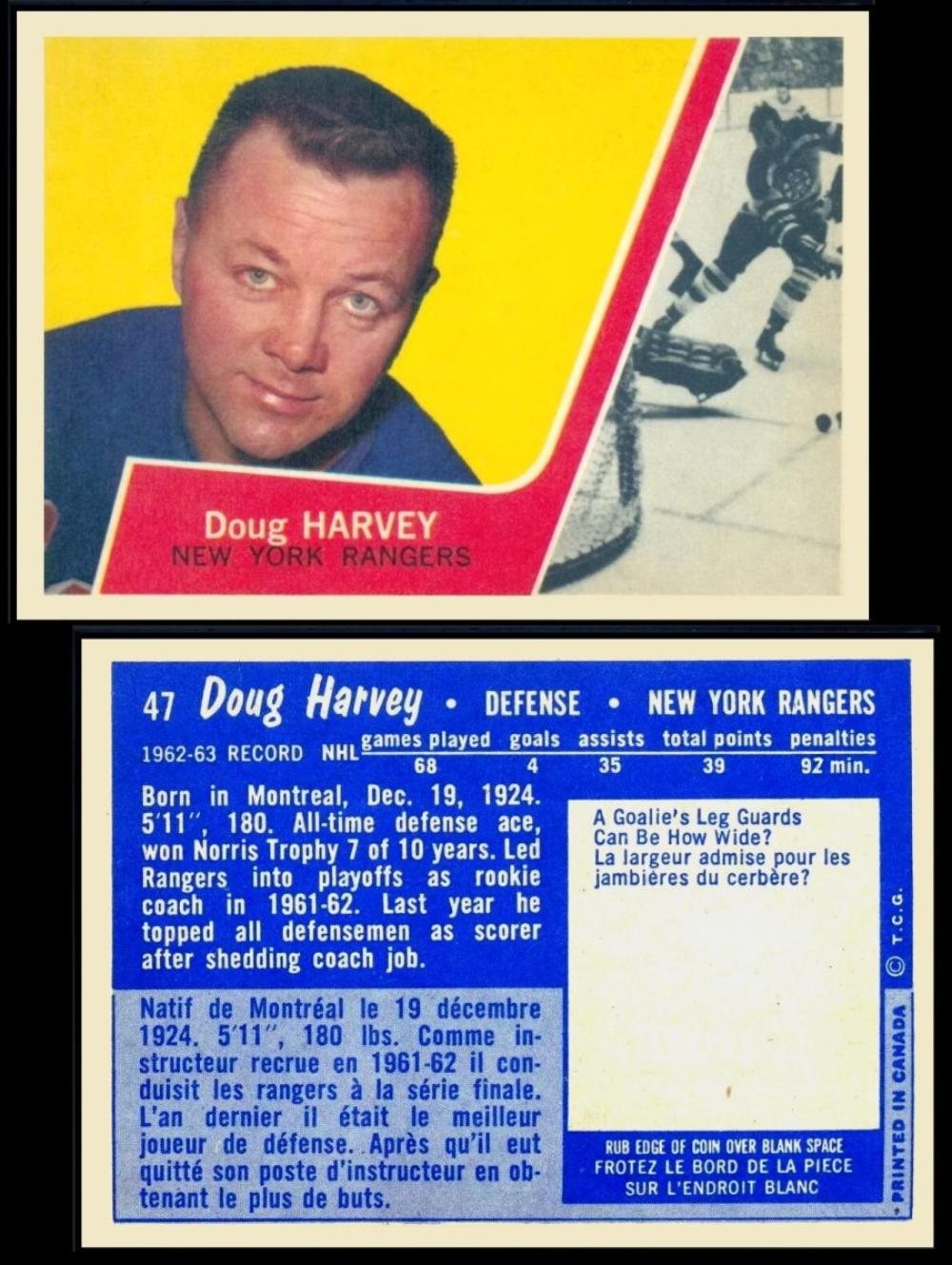
O-Pee-Chee [trade : bubble gum : O/S - Canada] "Hockey" untitled (1963-64) 47/66
Today, in 1924, Douglas Norman Harvey was born in Montreal, Canada. Centenaries have been a bit thin on the ground recently, so I am very glad to have fitted this one in.
Anyway he would later become a hockey player, in fact he is regarded as one of the best ever hockey players, so much so that he was elected to the Hockey Hall of Fame in 1973, just ten years after this card was issued.
His real fame did not begin until after his service, in the Royal Canadian Navy, in the Second World War. And though he is most remembered for his time with the Montreal Canadiens, which he joined after the end of the war, in 1947, he also played for the New York Rangers (from 1961 - as shown on this card - and also became their coach), as well as the Detroit Red Wings and the St. Louis Blues.
He died on December 26, 1989.
Now do be aware that there are two sporting Doug Harveys - the other is a baseball player called Harold Douglas Harvey, and he was born in March 1930 in California
This card was shown to me as Topps, but it seems that this is not the case. For one thing it is bi-lingual, in French and English, and for another it clearly states "Printed in Canada" up the right hand side - and yet, following that immediately it has the familiar "(c) T.C.G.C" for Topps.
A little research has discovered that these cards, being pre 1967, were actually released by O-Pee-Chee, in Canada - though on the actual packaging it says that they were "Made and distributed by O-Pee-Chee Co. Ltd. London, Ontario, under license with Topps Chewing Gum Inc. Brooklyn, New York". After 1967, and the expansion of the Hockey League to include American Teams, both Topps and O-Pee-Chee seem to have produced a set, though the Topps sets often have fewer cards.
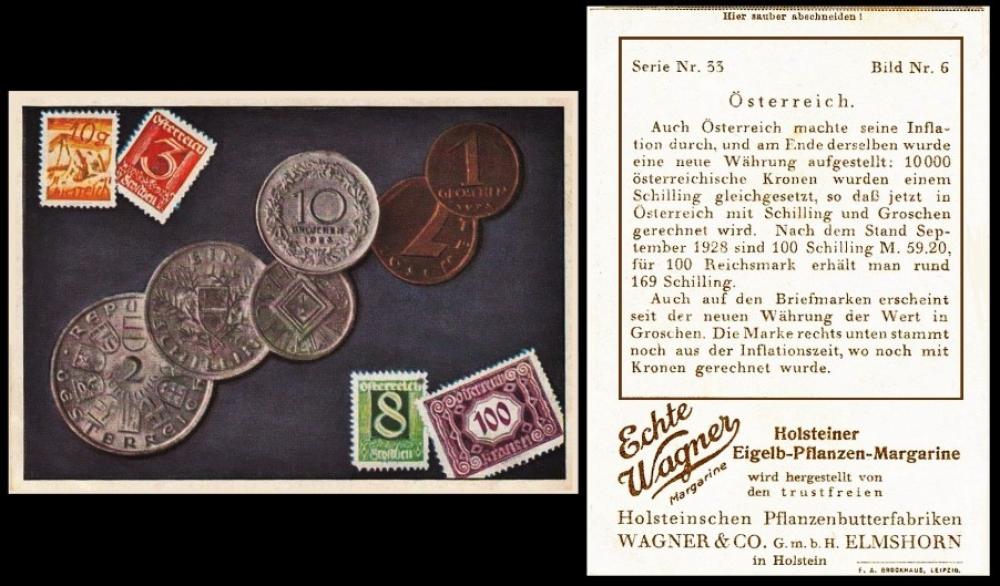
Echte WAGNER [trade : margarine : O/S - Elmshorn, Germany] "Eine Reise durch Osterreich" / "A Journey Through Austria" (1929) Album 2, Serie 33, card 6
So, to close, let us take a look at the Austrian Schilling, which was introduced on the 20th of December, 1924. Which makes it our second centenary card of the week, and in quick succession too.
Now there are several occurrences of coins of that name throughout history, starting with a famous reform to the coinage system in 794 AD. This schilling did not actually exist at the time, it was only used in a virtual sense in as much as twelve pfennigs made one schilling, though later on actual schilling coins were minted, right across Europe.
By the time of the middle ages there had been an adaptation and there were two values quoted for the schilling. The first was a short schilling, as above worth twelve pfennigs, but now also known as a groschen, which seems to be similar to our twelve pennies to a groat. The other coin was a long schilling, worth thirty pfennigs, and this seems to have continued for many centuries, long after the short schilling, right into the sixteenth century, at which time it was still worth the same thirty pfennigs.
In 1919, right at the end of the First World War, things had changed, and the Austro-Hungarian krone, formerly the coinage of Austria, as well as some other countries, fell foul of the breaking down of that regime. This led to the passing of the Schilling Act, governmental legislation, which came into force today in 1924. Only Austria had the Schilling though, the other countries, most of which were bordered by and became part of Switzerland, were given the Swiss Franc, and parts which were ceded to France has the French Franc. At that time this new schilling, made of silver, was worth ten thousand of the old kronen.
The schilling lasted until 1938, when Germany annexed Austria, and also forcibly introduced the reichsmark, which had to be exchanged at a rate of one and a half schillings to one reichsmark.
It was then brought back after the Second World War in 1945, but as paper money, not as coins. This time the exchange rate was fairer, one reichsmark for one schilling. The first coins were minted the following year, when supply of metals was steady enough to allow for that to take place. It remained one of Austria`s coins right until the introduction of the euro in 1999, at which time there were almost fourteen schillings to a euro, though once again there was no actual change to the money in pockets and wallets until it had been produced and that took until 2002. However, it was then, rather sweetly, subdivided into a hundred of our old friend, the groschen.
I must be honest, it was a reader who found the set name and the album number, which I may never have found, looking, as I was, for other cards of coins - for there is only this one card of coinage in the set, which is totally different from the rest, having a solid background.
The others, or rather the first words of the text, are
- Wilhelm Miklas (President of Austria from 1928 until Austria was annexed by Germany in 1938)
- Karte von Osterreich (a map of Austria)
- Wien (Vienna, a street scene with a policeman in the front)
- Der OpernPlatz (The Opera House in Vienna)
- Wahrend (the end of the First World War, or Armistice)
- Auch Osterreich (which means "also Austria", but it is our card of coins)
This week's Cards of the Day...
... have been celebrating James Buchanan Duke, and his decision to do good with his earnings. For on December the 11th, 1924, one hundred years ago, he sat down and signed the papers for what would become known as The Duke Endowment, this being a fund which would support many different causes to the amount of forty-million dollars.
His first thought was to provide education, hence Trinity College, which was founded by the Methodists (and the Quakers) in 1838, was to receive six million dollars, in exchange for renaming itself, after his father, to Duke University. Money also went to Davidson College, and Johnson C. Smith University, as well as to Furman University, who decided, all on their own, to rename their library after him, and so it remains, The James B. Duke Library. These centres of learning were not to be awarded a lump sum, the wording simply saying "ongoing support". Also mentioned in the bequests were several not-for-profit hospitals and childrens homes in both North and South Carolina, as well as the Methodist Church, specifically parishes in more rural areas, but also including retired pastors who found themselves in need. And when he did die, on October 10, 1925, half of his estate, almost seventy million more dollars, was also added to this endowment.
I have to say that I am very grateful to one of our readers who kindly shared of several scans from their vast collection of Duke cards, most of which I have never seen before. I am rather sad the week was not longer, as there were many more items that I would have loved to show you all. But perhaps one day we will revisit the theme. You never know.
So our clue cards this week were..... :
Saturday, 7th December 2024
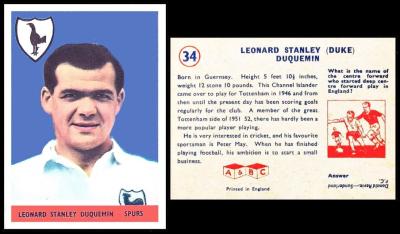
Here we have Leonard Stanley Duquemin, born in Guernsey, but shown here whilst playing for Tottenham Hotspur, which he joined at the start of 1946. As for the clue, well that was on the reverse of the card where it it tells you his nickname was "Duke".
He was born in July 1924, and though, as shown here, he played for Tottenham Hotspur, he was actually born in Guernsey - in fact, today, he is regarded as pretty much the first Channel Islands footballer to make it big in England.
He was one of a large family, his parents eventually having ten children, some before he was born and some after. He started his footballing career in Guernsey, under strange circumstances, for the occupying German Forces allowed the men to play football. Now they invaded in 1940, when he was sixteen, and stayed until 1945 . He must have come to the United Kingdom shortly after that, for at the start of 1946, after a successful trial, he was signed by Tottenham Hotspur - which seems to be the only team for whom he appears on cards. Not that many, either, the Trading Card Database /LDuquemin only having nine.
He left Tottenham Hotspur towards the end of 1958, and made a few appearances for other, smaller teams. Then he decided to retire for good, and bought a newsagents not too far away from the Tottenham ground. Eventually he did move away, to Barnet, where he ran a public house. He died in 2003, aged seventy-eight.
Our original British Trade Index part II tells us that this set is from the "Footballers Grouping" which appears in full with the Card of the Day for October 19 2024, simply because that was the first football set ever to be issued by A & B.C. Gum, in 1958-1959. All the other sets are tackled like today`s, in as much as they simply repeat their section of the listing, and not how it interacts with the other sets.
Now today`s card can be found in three different styles - and these are listed as :
FOOTBALLERS GROUPING (A). Md. or Lg. 8 backs illustrated at Fig. ABF-10. Nd. ... ABF-10
8. Portrait with crest added. Back 8, number in red circle. (92) Album issued.
A.89 x 64, back in (a) black and red (b) blue and red
B. 94 x 64, back black and red. Front inscribed "Send your name ... to Planet Ltd... N.W.1"
There is a problem with this list though, because the cards we show one of as our Card of the Day here are listed as section 8.A.b, but they were actually the third version to be issued.
First to be issued were the cards described here as 8.B, with the inscription to the front - you can see one of those as our Card of the Day for the 19th of October, 2024 - this was printed in the top border, and it was to be cut off and sent away to get your album - hence the shorter cards, listed here as section 8.A.a are only shorter because they have had the top margin, with the inscription, completely cut off, only leaving them with three borders, the bottom and the sides.
Then, later on, our set appeared, as a re-issue, in the format we show here, and in the same size that the mutilated cards ended up as, but with four, equally sized borders, and without the printing with the album offer. Luckily they also had blue and red backs, so we know these are set 8.A.b above.
Now you might think that by the time of our updated British Trade Index, part III, this would all have been sorted out. However it had not, and our set still remains as number 8. And it is actually worse, for there is not a word about the two different printings, nor the mutilated cards, all it says for our set being :
ABF-10 Footballer Grouping
8. Portraits with crest. (92). Issued 1958-59 in two batches 1/46 and 47/92
Sunday, 8th December 2024
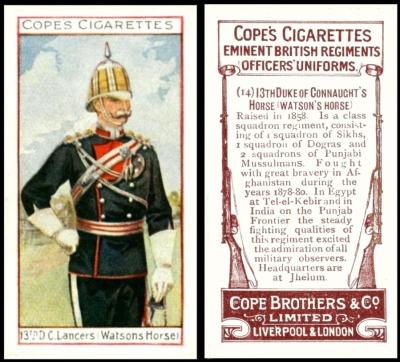
This clue also gave us Duke, for this is the thirteenth Duke of Connaught`s Horse, or, as it says on the front, the "13th D.C. Lancers, Watson`s Horse".
This regiment has a fascinating story, and shows well how fighting forces have had to change and modernise.
That story starts in 1857, with the founding of the 4th Sikh Irregular Cavalry, in Lahore, India, by two Lieutenants, H. Cattley and John Watson. Strangely, further research suggests that Lt. Watson did not join the regiment until 1860, shortly after which the name was changed several times, exchanging the 4th for the 13th, and the Sikh for Bengal. Lt. Watson seems to have straight away joined as a commandant, upon which he set about training the men to ride in a more English style. He is also reputed to have invented "posting", or raising your body out of the saddle whilst the horse is trotting, making it more comfortable for horse and rider. However this is debatable, as there are claims that it was invented, out of necessity, by postmen who travelled long distances across bumpy ground.
Commandant Watson may have thought his men needed riding instruction, but they were excellent fighters, so much so that after their exploits in the Anglo Egyptian War of 1882 they gained the favour of Queen Victoria`s third son, who was already both the Earl of Sussex, and the Duke of Connaught and Strathearn. He liked them so much that he requested that he be made Colonel-in-Chief. It is not reported what Commander Watson thought of this, but it takes until 1884, two years after the Anglo Egyptian War, before we have the first mention of the 13th Duke of Connaught`s Regiment of Bengal Lancers. This is not the end of the saga, either, because after dropping words hither and yon they end up in 1903 as simply the 13th Duke of Connaught`s Lancers. Then something must have happened, because not long after that, in 1904, they suddenly become the 13th Duke of Connaught's Own Lancers (Watson's Horse), which is how they are shown on our card.
After this things settle down, though the Regiment sees service both on the North Western Frontier and in Mesopotamia during the First World War. Once the war ends, though, lots of things in the military start to change, and the Indian Regiments are seen as too many, so in 1921 they are amalgamated with each other, and ours find themselves not only being joined with another Indian raised Regiment, the 16th Cavalry, but renamed into the rather clunky 13th/16th Cavalry. This must have jarred on everyone, for within a few months they were renamed as the 6th Duke of Connaught's Own Lancers - which, in 1927, for some reason, was renamed, to 6th Duke of Connaught's Own Lancers (Watson's Horse).
By the time of the Second World War, they still fought under this name, but they had been forced to adapt to modernity, and went into battle no longer mounted on horses, but instead equipped with tanks and armoured fighting vehicles. And the biggest change of all came with the Partition of India in 1947, where they left the British Army and became part of the Pakistan one. Though there has been yet another change since, for after Pakistan`s decision to become a Republic, in the mid 1950s, all reference to British royalty was understandably swept away, and so they are simply known as 6 Lancers
This set is also quite complex, but lets start with what looks like its full description in our original World Tobacco Issues Index, which reads :
EMINENT BRITISH REGIMENTS - OFFICERS UNIFORMS. Sm. 68 x 36. Nd. (25). Backs in shades of (a) brown (b) claret. ... C132-30
I must say that by looking just at this card, if you only had this one, you may be uncertain as to whether it is brown or claret, but fear not, some time I will add this card in the brown version, which I would tend to call more gold or dark yellow.
Returning to the complexity of this set, these are not the only two printings, for there is another version too, and it is listed in our original World Tobacco Issues Index, just not in the same section. And there is no link between them. This third version appears in the next section down, namely : "The `Contrabando` Issues. Danish language issues. Except for Set C132-42 [Scandinavian Actors & Actresses"] the series have the same fronts as in the equivalent English set in 2A above, with backs reprinted in Danish." The Danish set is therefore listed as : "Uniformer af Fremragende Britiske Regimenter (Eminent British Regiments - Officers Uniforms). Sm. 68 x 36. Nd. (25) ...C132-44"
In our updated World Tobacco Issues Index the text of both of these listings remains the same, but the codes have altered to higher numbers.
Monday, 9th December 2024
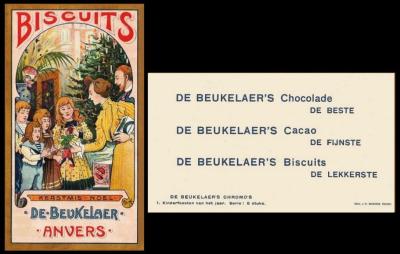
So here we simply have the most basic form of an endowment, a gift, given with love, in this case a small child receiving a doll. However if kindnesses are shown to a child it is hopefully the case that the child, as they mature, will also think of how they can help others. And though the more cynical may think that Mr. Duke was only making sure he could be remembered, he seems to have chosen wisely, schools for the young and churches for the needy.
So as you can see I am struggling with this one. I thought it an advertising card, until I saw that at the bottom of the reverse it has a title "1. Kinderfesten von het jaar". Now I translated that as Children`s festivals throughout the year, thinking this was Christmas, but now it seems that `Kinderfesten` means birthday party.
However, that`s definitely a Christmas tree!
Therefore if any readers have any other cards in this set, please send us the titles - along with, if you know such, the date, and the number that makes up a full set.
Tuesday, 10th December 2024
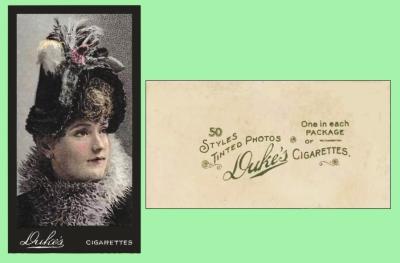
This group is recorded in our original World Tobacco Issues Index as :
TINTED PHOTOS. Sm. Girls, bust length portraits. Unnd. (50). Subjects unnamed. Ref. USA/89. See X2/89. ... D76-46
A. Small cards with black border
B. Portraits diecut to shape
This text is the same in our updated World Tobacco Issues Index except that it is missing the reference to X2/89 - this is because it appears in the Handbook to the original World Index, which at first was issued as a separate volume, but later combined together. This entry is very interesting for it shows a photo of the first forty-nine cards in a block, which must have appeared elsewhere, most probably in a cartophilic magazine, and, even more interestingly, it must have done so before the fiftieth card was discovered.
I am not sure whether the picture will reproduce well, it is rather dark, but I will do my best and add it for interest - and in any case I have discovered that all of the cards, including the die-cuts, are available to view at the Movie Card Website/89. They have also done a comparison checklist between the standard cards and the die cuts which is really fascinating.
Anyway, the description of these cards in that Handbook to our original World Tobacco Issues Index reads :
X2/89 TINTED PHOTOS. Small size. Issued by Duke. Unnumbered series of 50, of which 49 illustrated at Fig. X2/89. The 50th subject is a girl without hat or headdress, without jewellery, very low dress.
A. Small size cards, with black borders
B. Portraits die cut to shape.
As far as USA/89, that takes us to Jefferson Burdick`s American Card Catalogue, where they are described as :
89 - Tinted Photos (50) girls, black border
a) ordinary small cards b) die cut to shape
He values them all at twenty-five cents each.
Wednesday, 11th December 2024
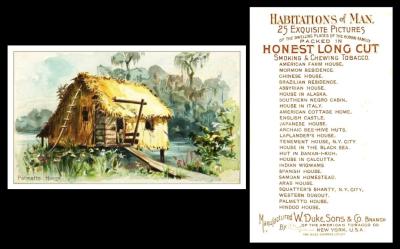
This structure is called a "Palmetto House", and it is made of parts of the fan palm, or saw palmetto.
Now if you put the phrase "Palmetto House" in a search engine today, you will find nothing like the one on this card. This seems to be because there has been a name change, for today we call this sort of house a palapa, a word which is actually Spanish, and means the stalk of a palm, especially the part where the leaf joins the stalk.
Further research has confused the issue still further, for it has discovered that a palapa is an open sided dwelling with a roof only of thatch - which is not the same as our building. However the palapa is built on stilts and most usually above the water, as showing here. And it seems likely that the artist had never seen one, and just filled in the sides without knowing any better - though to be honest the Spanish had never seen one either, they only heard of them when their explorers discovered the Phillippines, and brought back vague tales of palm leaved huts on the beach.
In our original World Tobacco Issues Index this set is listed as :
HABITATIONS OF MAN. Lg. Bkld. (25). Ref. USA/113. ... D76-23
And this text remains the same in our updated version of that work.
As far as USA/113, that is again Jefferson Burdick`s American Card Catalogue, where the set is described as :
113. Habitations of Man (25)
and valued at forty cents a card.
Now we know that the set was lithographed by the Giles Co., New York, and that they worked for Duke on several sets, including "Tricks with Cards" (1187), and "Presidential Possibilities" (N.124 - 1888),
By the way, you can see all the cards of this set at moviecard.com/N113 - and marvel at the curious dwellings which are portrayed, some of which seem also to be confections. The English Castle is the most intriguing, for it seems to be made of several structures, it is not quite Warwick, and not quite Alnwick.
Thursday, 12th December 2024
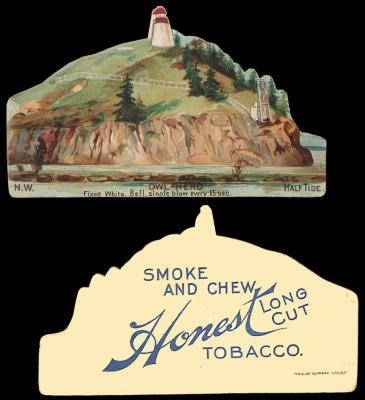
Here we have Owls Head Lighthouse, which is just at the entrance of Rockland Harbour in Maine, America. It is surrounded by land which is now a State Park, and so protected. The lighthouse is not named Owls Head because of its shape, but because it stands on a peninsula which resembles one.
It was built in 1852, and shortly after that a little house was built to form a home for the lighthouse keeper. This is now a museum. However his electricity supply seems to have been sporadic until 1895 when a generator was supplied him.
The lighthouse was restored in 2010 and repainted, and it is much written that today it looks much as it did when it was originally built in 1852. However this is not strictly true, as the 1852 structure was a rebuild; there was an earlier structure, built in 1825 by Jeremiah Berry and Green & Foster, as a thirty feet tall tapering cylinder of brick. I have not been able to find out what happened to this, whether it was demolished either partially or completely by storm, or whether it was just changed a bit into the structure on this card.
We do know that this lighthouse also appears in the American Tobacco Company`s "Hassan" branded "Lighthouse Series" a set of fifty large unnumbered cards known as T.77. And maybe on other sets that I do not know about.
In our original World Tobacco Issues Index our set is described as :
LIGHTHOUSES (A) Lg. Die-cut to shape. Unnd. (25) "Honest Long Cut" brand issue. See ABC/119. Ref. USA/119.a ... D76-29
It is very slightly different in our updated version of this work, reading :
LIGHTHOUSES (A) Lg. Die-cut to shape. Backs in blue. Unnd. (25) "Honest Long Cut" brand issue. Ref. USA/119.a ... D900-270
Now if we go to that USA/119, which refers to Jefferson Burdick`s American Card Catalogue, the set is described, with a twist, as
119 - Lighthouses (25) die-cut to shape.
(a) Duke issue (b) Gail & Ax issue.
He makes no differentiation between the two as far as value though, giving just one price, of 40 cents a card.
As I still have a smidgeon of time, lets squeeze in a small note about the G.W. Gail and Ax version. Now they were taken over by American Tobacco in 1891 but we know that this set, and several others, were prepared before this date, and it seems that these cards were issued in 1890. The entry for them in our World Tobacco Issue Indexes reads much the same as the Duke entry, namely: "LIGHTHOUSES (A) Lg. Die-cut to shape. Unnd. (25) Ref. USA/119.b ... G040-450". The odd thing, though, is that there is no cross reference to the Duke issues from here, and vice versa, save the fact that there is a 119.a and a 119.b.
I have not seen a Gail & Ax version of this card, but the few I have seen are very similar regarding the reverse text, which is again only text, reading "SMOKE AND CHEW / G. W. GAIL & AX`S / NAVY" plus a diamond shaped logo with a big "G", and the words "TRADE" "MARK" along the rising edges of the bottom.
They were also printed by The Giles Company.
Friday, 13th December 2024
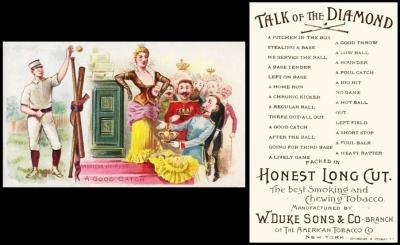
Here we have a most unusual set that a lot of collectors, even baseball ones, know nothing about. The stumbling block seems to be the title, for it sounds like jewellery. It is only when you see the card, with its baseball player to one side, that the penny, or maybe the ball, starts to drop.
On the other side to the baseball player, separated by a bat, is a comical image which takes a phrase commonly used in baseball and applies it to another meaning - so in this case we have "A Good Catch", the sporting meaning of which is when a player catches a ball in his hand, especially if it was unexpected that he would be able to do so.
However, in our drawing, a lady has caught herself a royal suitor, and he is going to far as to offer her his crown. Americans always seem to believe that catching themselves some kind of royalty makes up for the fact that their life with them will probably be very dull, and the love quite lacking, sometimes on both sides. It is also rather telling that in their set of "Habitations of Man" the English are represented by a castle. Sadly, this is still the case with many high profile marriages, which have come to include members of social media "royalty"; however, the truth still remains that a better match is often found with someone closer to home, where the money may be tight, but the friendship and maybe even love, makes up for all of that.
This set is described in our original World Tobacco Issues Index as :
TALK OF THE DIAMOND. Lg. A.T.C. back. Bkld (25). Ref. USA/135 ... D76-44
If we head over to Jefferson Burdick`s American Card Catalogue, the set is listed as :
135 - Talk of the Diamond (25) comics
This is almost certainly why there is no mention of baseball in our reference books either, for much of the American card details were extracted from Jefferson Burdick`s findings. As he did not mention baseball, and probably did not supply an actual card, just his wordings, the connection was not made on our side of the Atlantic. Today, with the internet, this kind of error is way less likely to occur, as we can simply scan a card and include it. That was not so easy in the 1950s when this great work was being compiled.
And, by the way, Jefferson Burdick values them at 40 cents a card
And there we must halt our investigations for another week. Time has beaten me, once more, and I must now put away these things and prepare to start anew on Sunday, Saturday being reserved for all the other things I neglected in the quest to get this newsletter out in time.
I am not sure why I ever considered a weekly newsletter, but it was one of the things I rashly promised when I first offered to work on your website. Since then it has endured, and usually on time, despite there being many interruptions; oddly when I was off camping in a field with not a whiff of internet it still arrived on time; whilst the week in which I somehow went to two concerts within three days everything, not just the newsletter, was a casualty. As for the third concert, in July of this year, at least that was on a Saturday, and I made myself knuckle down and have the newsletter entirely written by the Wednesday.
I have found writing them amusing, inspiring, and also educational, and it continues to amaze me how many headlines and birthdays can be linked to cards. Some weeks my writing has been in the middle of sad news, even of departures, and I have found that it has given me something to keep going for, as well as provided a diversion from thinking of those wretched and most unwanted changes to things and companions I thought would always be part of my life.
I am not sure how long I will continue, for that is not up to me, it is entirely commanded by some unknown being in the clouds, maybe even in a spaceship, who allots our span on this earth and can cancel it on a whim, without a single chance of bribery, or cajoling, being allowed to alter their decision. But I hope to continue for some time yet.
This week, on the eleventh, I realised that I had been a member of the Cartophilic Society for forty-five years, which is quite an accomplishment. I cannot, off the top of my head, think of many who have lasted for an entire half century, but I will consider myself privileged, indeed, should I be allowed to join them.
